Decomposition of Intensity and Sustainable Use Countermeasures for the Energy Resources of the Northwestern Five Provinces of China Using the Logarithmic Mean Divisia Index (LMDI) Method and Three Convergence Models
Abstract
1. Introduction
2. Materials and Methods
2.1. Data Source and Processing
2.2. LMDI Decomposition Method
2.3. Convergent Regression Method
2.3.1. Energy Intensity σ Convergence
2.3.2. Energy Intensity β Convergence Regression Test
2.3.3. Absolute β Convergence
2.3.4. Conditional β Convergence
3. Results
3.1. Trends in Energy Intensity in the Five Northwestern Provinces of China
3.2. Energy Intensity Decomposition Results
3.2.1. Industrial Structure Effect
3.2.2. Industrial Energy Intensity Effect
3.2.3. Energy Structure Effect
3.2.4. Contribution Rate of Energy Intensity by Industry Sub-Sectors
3.3. Energy Intensity Convergence
3.3.1. σ Convergence
3.3.2. Absolute β Convergence of Energy Intensity
3.3.3. Conditional β Convergence of Energy Intensity
4. Discussion
5. Conclusions and Suggestions
5.1. Conclusions
5.2. Suggestions
6. Limitations and Future Research Directions
Author Contributions
Funding
Data Availability Statement
Conflicts of Interest
Appendix A
| Groupings | Categories | |
|---|---|---|
| Primary Industry | Agriculture, forestry, animal husbandry, and fishery | |
| Secondary Industry | Industry | Mining Manufacturing Electricity, heat, gas and water production, and supply industry |
| Construction | Construction industry | |
| Tertiary Industry | Wholesale, retail, accommodation, and catering Transportation, storage, and postal industry Information transmission, software, and information technology services Financial industry Real estate industry Leasing and business services Scientific research and technical services Water, environment, and public facilities management industry Residential services, repairs, and other services Education Health and social work Culture, sports, and entertainment Public administration, social security, and social organizations | |
| Number | Industry |
|---|---|
| I1 I2 I3 I4 I5 I6 I7 I8 I9 I10 I11 I12 I13 I14 I15 I16 I17 I18 I19 I20 I21 I22 I23 I24 I25 I26 I27 I28 I29 I30 I31 I32 I33 I34 I35 I36 | Coal mining and washing Extraction of petroleum and natural gas Ferrous metal mining industry Non-ferrous metal mining industry Non-metallic mining industry Agricultural and sideline food processing industry Food manufacturing Beverage manufacturing Tobacco manufacturing Textile industry Textile and apparel industry Leather, fur, down, and products Wood processing and wood, bamboo, rattan, palm, and grass products industry Furniture manufacturing Paper and paper products industry Printing and recording media reproduction industry Cultural, educational, industrial, sports, and recreational goods manufacturing Petroleum processing, coking, and nuclear fuel processing industry Chemical raw materials and chemical products manufacturing Pharmaceutical manufacturing Chemical fiber manufacturing Rubber and plastic products industry Non-metallic mineral products industry Ferrous metal smelting and rolling processing industry Non-ferrous metal smelting and rolling processing industry Metal products industry General equipment manufacturing Specialized equipment manufacturing Transportation equipment manufacturing Electrical machinery and equipment manufacturing Communications and other electronic equipment manufacturing Instrument manufacturing Other manufacturing Electricity and heat production and supply industry Gas production and supply industry Water production and supply industry |
References
- Fuzhan, X. China’s Economic Development and Development Economics Innovation. Soc. Sci. China 2019, 40, 100. [Google Scholar] [CrossRef]
- China Agenda 21. White Paper on China’s Population, Environment and Development in the 21st Century; China Environmental Science Press: Beijing, China, 1994. [Google Scholar]
- Hewitt, N.J. Decarbonizing Energy of a City: Identifying Barriers and Pathways. Energies 2024, 17, 267. [Google Scholar] [CrossRef]
- Augutis, J.; Krikštolaitis, R.; Martišauskas, L.; Urbonienė, S.; Urbonas, R.; Ušpurienė, A.B. Analysis of energy security level in the Baltic States based on indicator approach. Energy 2020, 199, 117427. [Google Scholar] [CrossRef]
- Atstāja, D. Renewable Energy for Sustainable Development: Opportunities and Current Landscape. Energies 2025, 18, 196. [Google Scholar] [CrossRef]
- Liu, X.; Huang, Y.; Shi, X.; Bai, W.; Huang, S.; Li, P.; Xu, M.; Li, Y. Offshore Wind Power—Seawater Electrolysis—Salt Cavern Hydrogen Storage Coupling System: Potential and Challenges. Energies 2025, 18, 169. [Google Scholar] [CrossRef]
- Juntueng, S.; Towprayoon, S.; Chiarakorn, S. Assessment of energy saving potential and CO2 abatement cost curve in 2030 for steel industry in Thailand. Environ. Dev. Sustain. 2021, 23, 2630–2654. [Google Scholar] [CrossRef]
- Zhong, J.; Bollen, M.; Rönnberg, S. Towards a 100% renewable energy electricity generation system in Sweden. Renew. Energy 2021, 171, 812–824. [Google Scholar] [CrossRef]
- BP Statistical Review. BP Statistical Review of World Energy. Available online: http://www.bp.com/statisticalreview (accessed on 5 May 2024).
- National Bureau of Statistic of China. China Energy Statistical Yearbook. 2019. Available online: https://www.stats.gov.cn/sj/ndsj/ (accessed on 7 May 2024).
- Du, X. Energy Revolution: For a Sustainable Future. China Popul. Resour. Environ. 2014, 24, 1–4. (In Chinese) [Google Scholar] [CrossRef]
- Lin, B.; Xu, M. Quantitative assessment of factors affecting energy intensity from sector, region and time perspectives using decomposition method: A case of China’s metallurgical industry. Energy 2019, 189, 116280. [Google Scholar] [CrossRef]
- Zeng, L.; Lu, H.; Liu, Y.; Zhou, Y.; Hu, H. Analysis of Regional Differences and Influencing Factors on China’s Carbon Emission Efficiency in 2005–2015. Energies 2019, 12, 3081. [Google Scholar] [CrossRef]
- Wang, Z.; He, W. Regional energy intensity reduction potential in China: A non-parametric analysis approach. J. Clean. Prod. 2017, 149, 426–435. [Google Scholar] [CrossRef]
- Ahmad, F.; Draz, M.U.; Ozturk, I.; Su, L.; Rauf, A. Looking for asymmetries and nonlinearities: The nexus between renewable energy and environmental degradation in the Northwestern provinces of China. J. Clean. Prod. 2020, 266, 121714. [Google Scholar] [CrossRef]
- Zhang, H.; Shen, L.; Zhong, S.; Elshkaki, A. Economic Structure Transformation and Low-Carbon Development in Energy-Rich Cities: The Case of the Contiguous Area of Shanxi and Shaanxi Provinces, and Inner Mongolia Autonomous Region of China. Sustainability 2020, 12, 1875. [Google Scholar] [CrossRef]
- Zhou, X.; Zhou, M.; Zhang, M. Contrastive analyses of the influence factors of inter-provincial carbon emission induced by industry energy in China. Nat. Hazard. 2016, 81, 1405–1433. [Google Scholar] [CrossRef]
- Ren, B.; Zhang, X. The Evolution of the Development Process of Industrialization in New China in 70 Years and Its Future Trends. J. Xi’an Univ. Financ. Econ. 2019, 4, 17–23. (In Chinese) [Google Scholar]
- Jia, J.; Ma, G.; Qin, C.; Wang, L. Place-based Policies, State-Led Industrialisation, and Regional Development: Evidence from China’s Great Western Development Programme. Eur. Econ. Rev. 2020, 123, 103398. [Google Scholar] [CrossRef]
- Xiao, B.; Niu, D.; Guo, X. The driving forces of changes in CO2 emissions in China: A structural decomposition analysis. Energies 2016, 9, 259. [Google Scholar] [CrossRef]
- Wang, W.; Liu, X.; Zhang, M.; Song, X. Using a new generalized LMDI (logarithmic mean Divisia index) method to analyze China’s energy consumption. Energy 2014, 67, 617–622. [Google Scholar] [CrossRef]
- Ang, B.W. Decomposition analysis for policymaking in energy: Which is the preferred method? Energy Policy 2004, 32, 1131–1139. [Google Scholar] [CrossRef]
- Zheng, X.; Lu, Y.; Yuan, J.Y.B.; Zhang, S.; Nils, C.; Dag, O.H.S.; Tian, M.O.; Deliang, C. Drivers of change in China’s energy-related CO2 emissions. Proc. Natl. Acad. Sci. USA 2020, 117, 29–36. [Google Scholar] [CrossRef]
- Jia, J.; Lei, J.; Chen, C.; Song, X.; Zhong, Y. Contribution of Renewable Energy Consumption to CO2 Emission’s Mitigation: A Comparative Analysis from a Global Geographic Perspective. Sustainability 2021, 13, 3853. [Google Scholar] [CrossRef]
- Jaunky, V.C.; Zhang, L. Convergence of operational efficiency in China’s provincial power sectors. Energy J. 2016, 37, 3–28. [Google Scholar] [CrossRef]
- Barro, R.J. Convergence. J. Political Econ. 1992, 100, 223–251. [Google Scholar] [CrossRef]
- Sala-I-Martin, X. The Classical Approach to Convergence Analysis. Econ. J. 1996, 106, 1019–1036. [Google Scholar] [CrossRef]
- Mussini, M. Inequality and convergence in energy intensity in the European Union. Appl. Energy 2020, 261, 114371. [Google Scholar] [CrossRef]
- Solarin, S.A. Parametric and non-parametric convergence analysis of electricity intensity in developed and developing countries. Environ. Sci. Pollut. Res. 2019, 26, 8552–8574. [Google Scholar] [CrossRef]
- Zhang, P.; Wang, X.; Zhang, N.; Wang, Y. China’s energy intensity target allocation needs improvement! Lessons from the convergence analysis of energy intensity across Chinese Provinces. J. Clean. Prod. 2019, 223, 610–619. [Google Scholar] [CrossRef]
- Li, W.J.; Zhang, M.; Ouyang, J.; Shi, W. Regional differences in carbon emission of China’s industries and its decomposition effects. J. Clean. Prod. 2020, 270, 122528. [Google Scholar] [CrossRef]
- Guan, W.; Xu, S. Study of spatial patterns and spatial effects of energy eco-efficiency in China. J. Geogr. Sci 2016, 26, 1362–1376. [Google Scholar] [CrossRef]
- Ang, B.W. LMDI decomposition approach: A guide for implementation. Energy Policy 2015, 86, 233–238. [Google Scholar] [CrossRef]
- Pettersson, F.; Maddison, D.; Acar, S.; Soderholm, P.D. Convergence of Carbon Dioxide Emissions: A Review of the Literature. Int. Rev. Environ. Resour. Econ. 2014, 7, 141–178. [Google Scholar] [CrossRef]
- Pesaran, M.H. On the interpretation of panel unit root tests. Econ. Lett. 2012, 116, 545–546. [Google Scholar] [CrossRef]
- Levin, A.; Lin, C.F.; Chu, C.S.J. Unit root tests in panel data: Asymptotic and finite sample properties. J. Econom. 2002, 108, 1–24. [Google Scholar] [CrossRef]
- Choi, I. Unit root tests for panel data. J. Int. Money Financ. 2001, 20, 249–272. [Google Scholar] [CrossRef]
- Kao, C. Spurious regression and residual-based tests for cointegration in panel data. J. Econom. 1999, 90, 1–44. [Google Scholar] [CrossRef]
- Yu, B. Economic Growth Effects of Industrial Restructuring and Productivity Improvement—An Analysis Based on Dynamic Spatial Panel Model of Chinese Cities. China Ind. Econ. 2015, 12, 85–100. (In Chinese) [Google Scholar]
- Wang, Z.; Wang, L. Research on the relationship between R&D input, industrial structure upgrading and carbon emission. Ind. Technol. Econ. 2019, 5, 64–72. (In Chinese) [Google Scholar]
- Huang, C.; Zhou, Y.J.; Cheng, J.H. Research on Energy-Related CO2 Emissions Characteristics, Decoupling Relationship and LMDI Factor Decomposition in Qinghai. Front. Energy Res. 2021, 9, 700385. [Google Scholar] [CrossRef]
- Xin, L.; Jia, J.; Hu, W.; Zeng, H.; Chen, C.; Wu, B. Decomposition and Decoupling Analysis of CO2 Emissions Based on LMDI and Two-Dimensional Decoupling Model in Gansu Province, China. Int. J. Environ. Res. Public Health 2021, 18, 6013. [Google Scholar] [CrossRef]
- Qin, J.; Tao, H.; Zhan, M.; Munir, Q.; Brindha, K.; Mu, G. Scenario Analysis of Carbon Emissions in the Energy Base, Xinjiang Autonomous Region, China. Sustainability 2019, 11, 4220. [Google Scholar] [CrossRef]
- Zhao, X.; Fan, L. Spatial distribution characteristics and convergence of China’s regional energy intensity: An industrial transfer perspective. J. Clean. Prod. 2019, 233, 903–917. [Google Scholar] [CrossRef]
- Jiang, L.; Bai, L. Study on Spatial Distribution and Convergence of China’s Energy Intensity—Analysis Based on Dynamic Spatial Panel Model. West Forum 2014, 24, 61–69. (In Chinese) [Google Scholar]
- Yu, H. The influential factors of China’s regional energy intensity and its spatial linkages: 1988–2007. Energy Policy 2012, 45, 583–593. [Google Scholar] [CrossRef]
- Huang, J.; Zheng, X.; Wang, A.; Cai, X. Convergence analysis of China’s energy intensity at the industrial sector leve. Environ. Sci. Pollut. Res. 2019, 26, 7730–7742. [Google Scholar] [CrossRef]
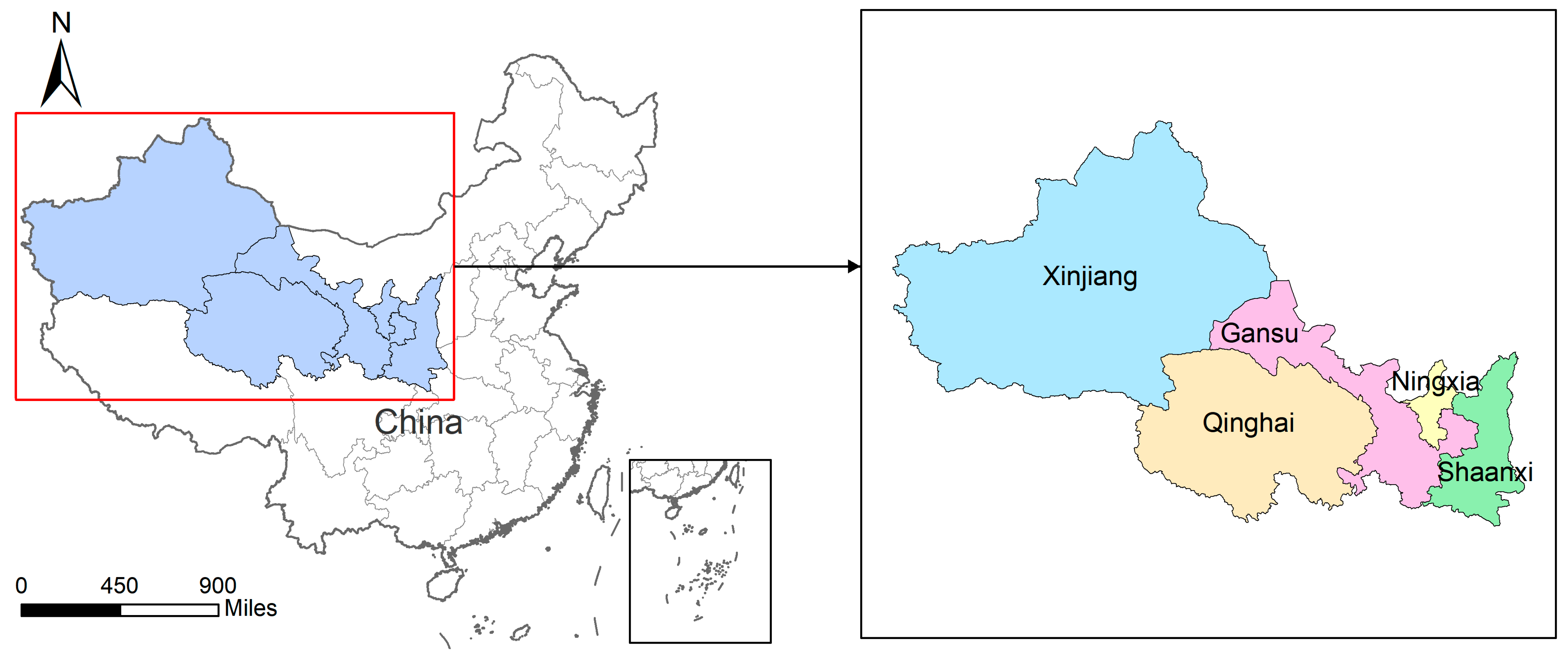
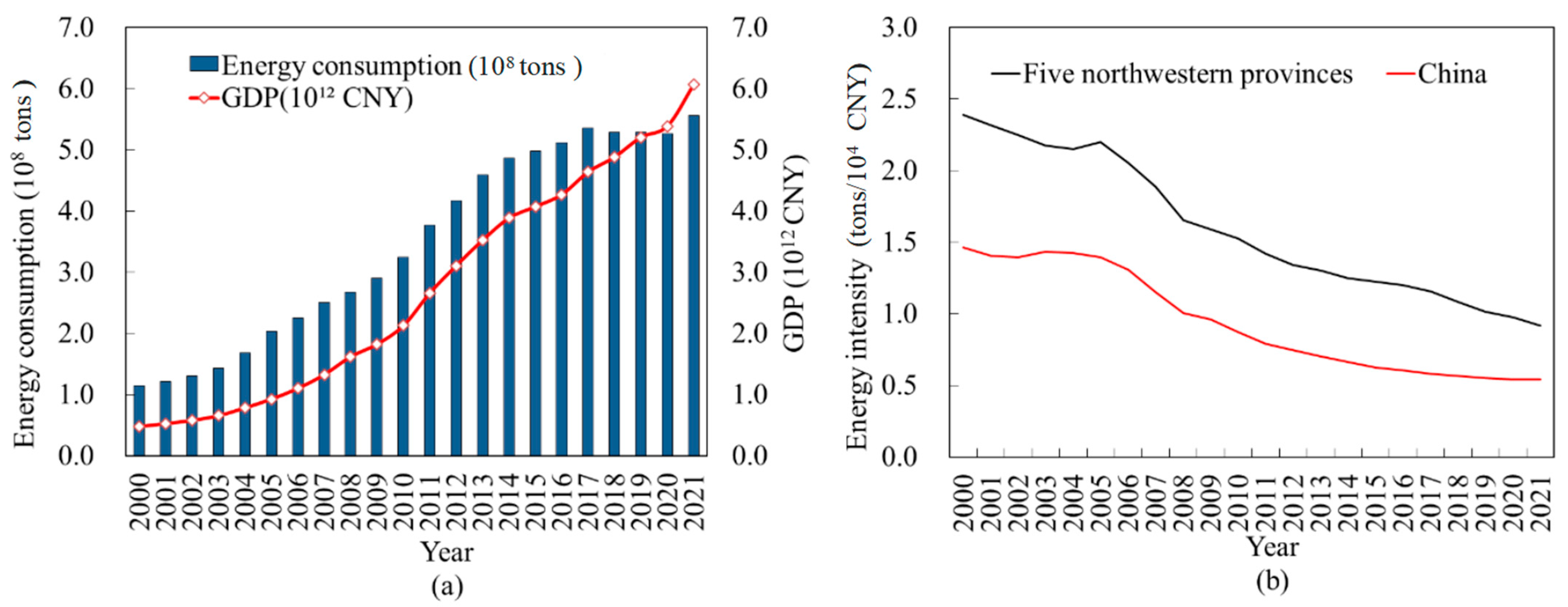
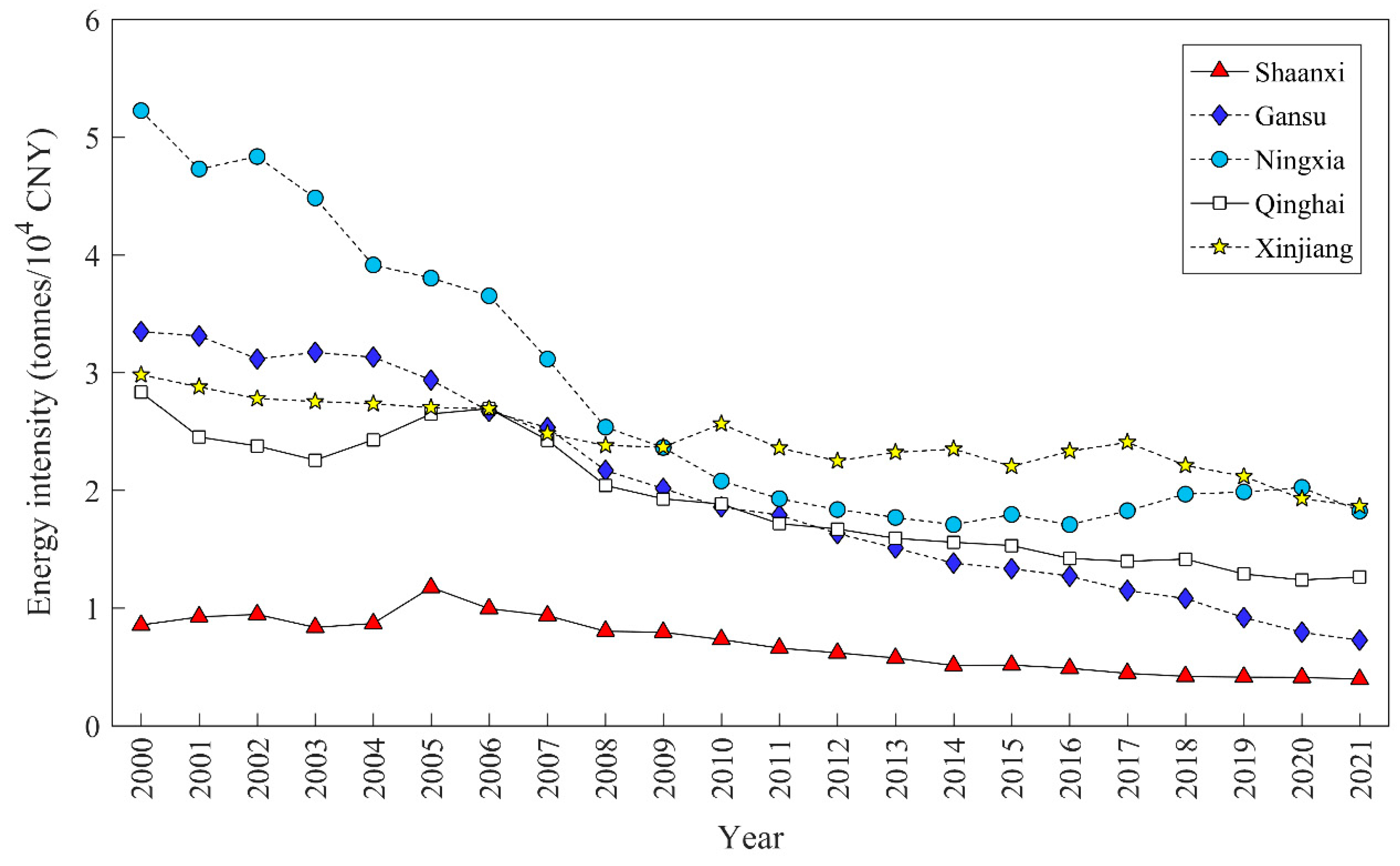
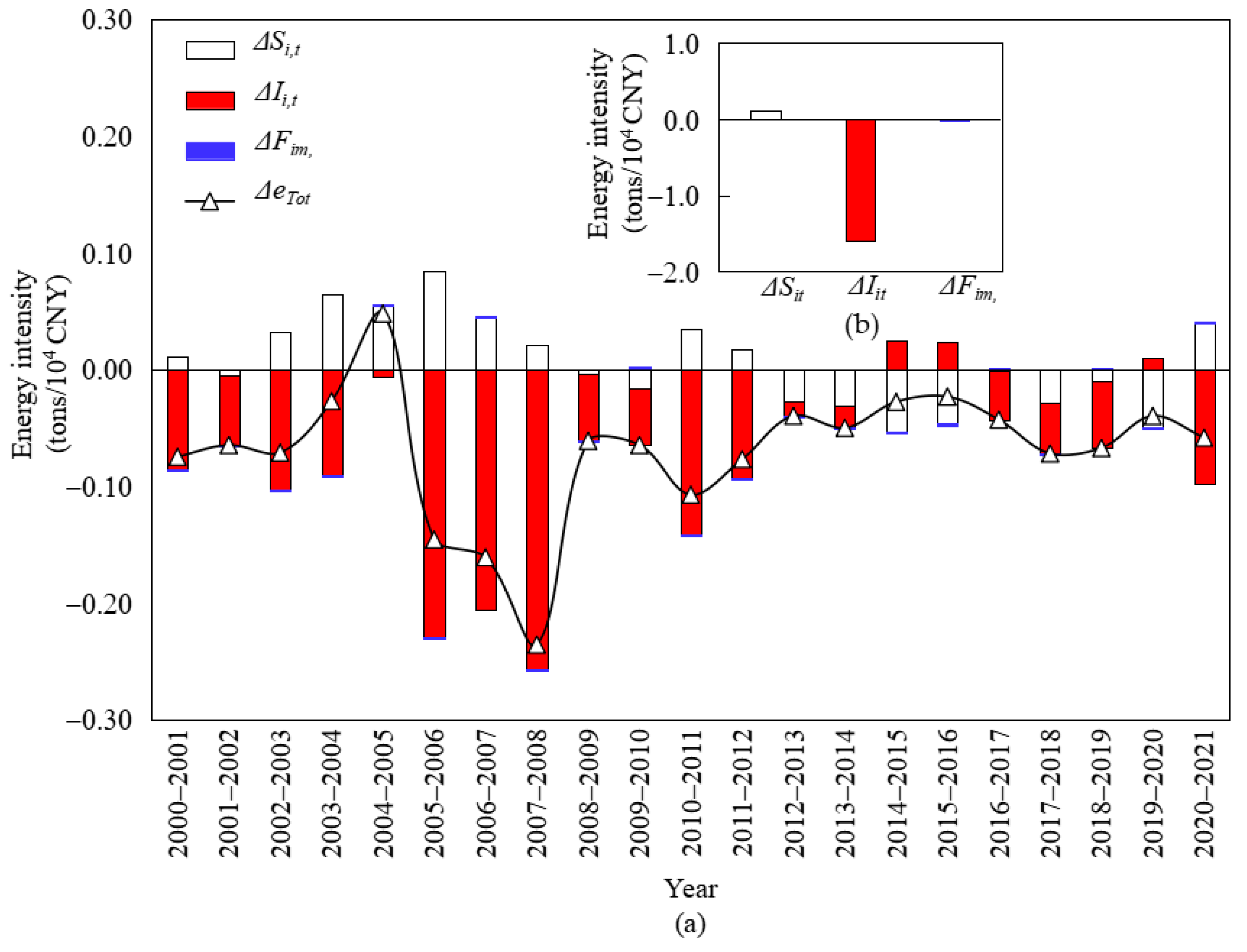
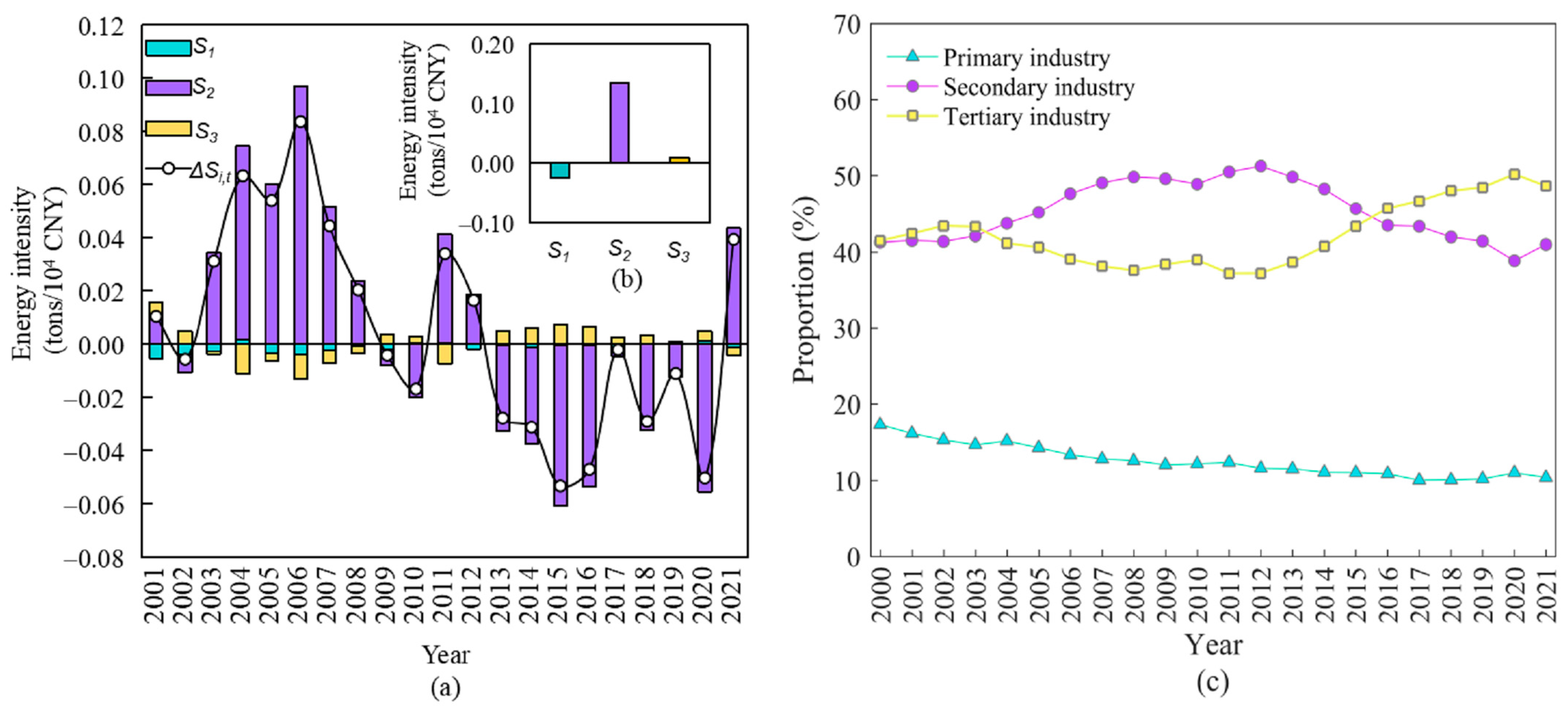
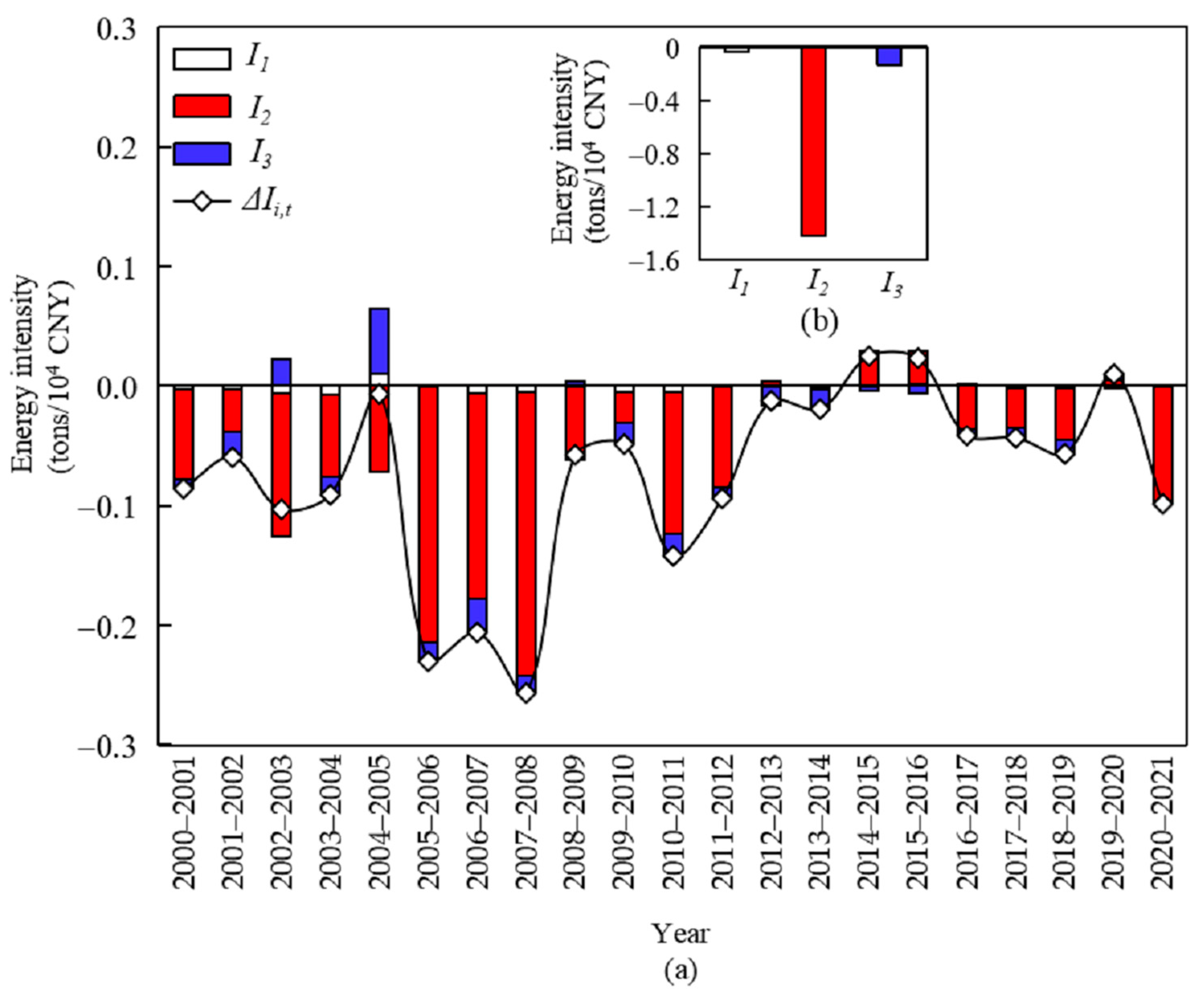
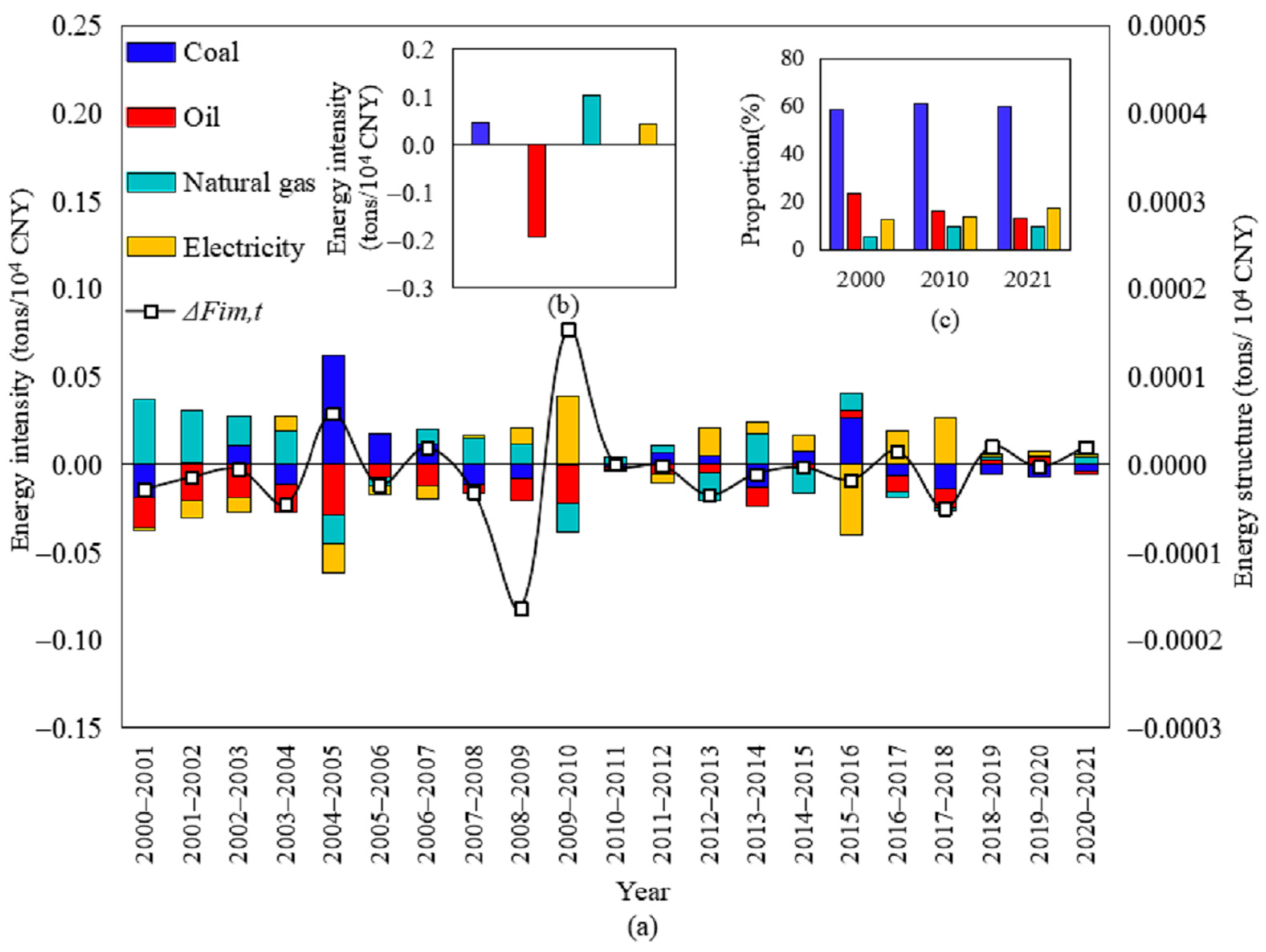
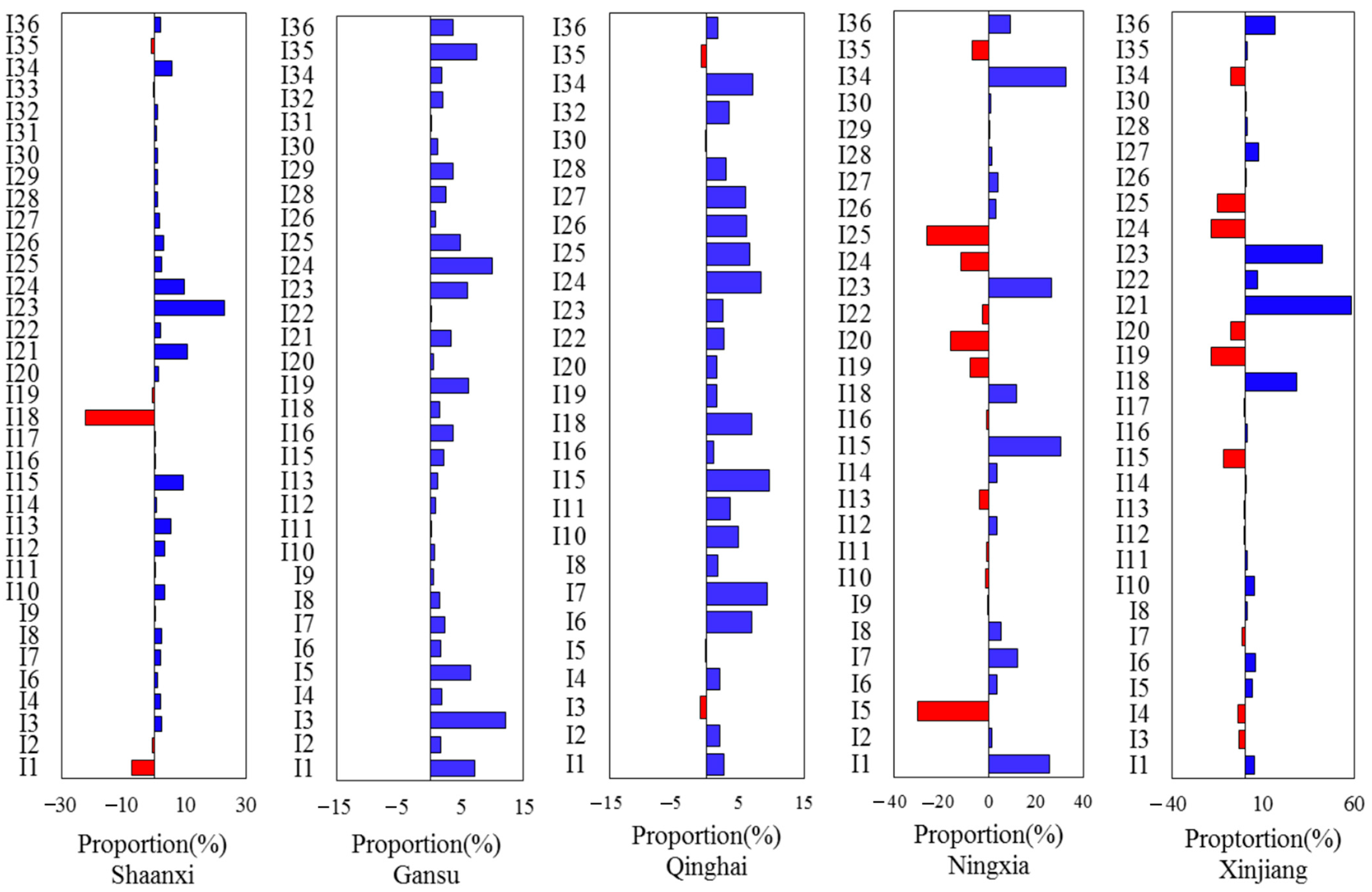
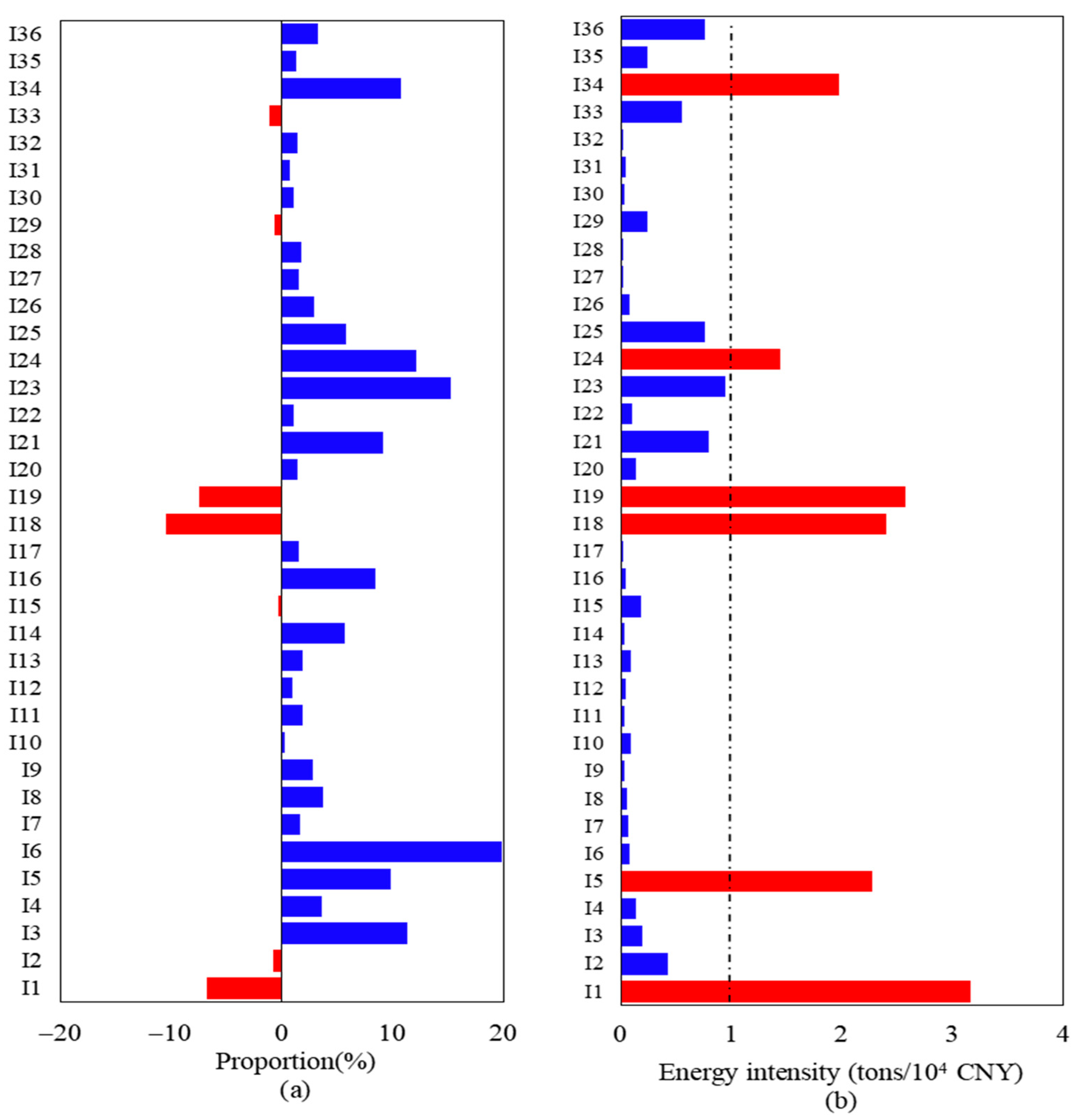
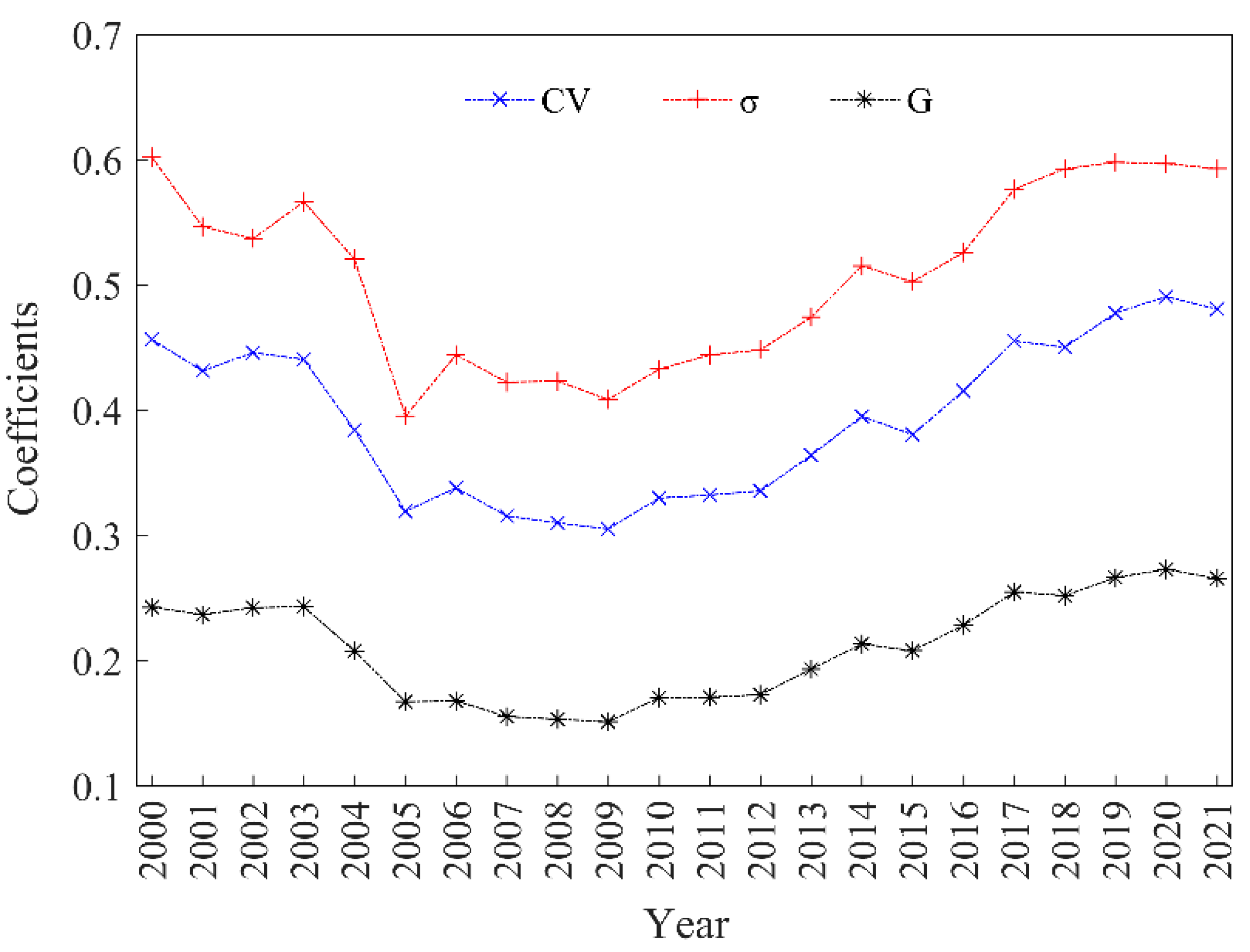
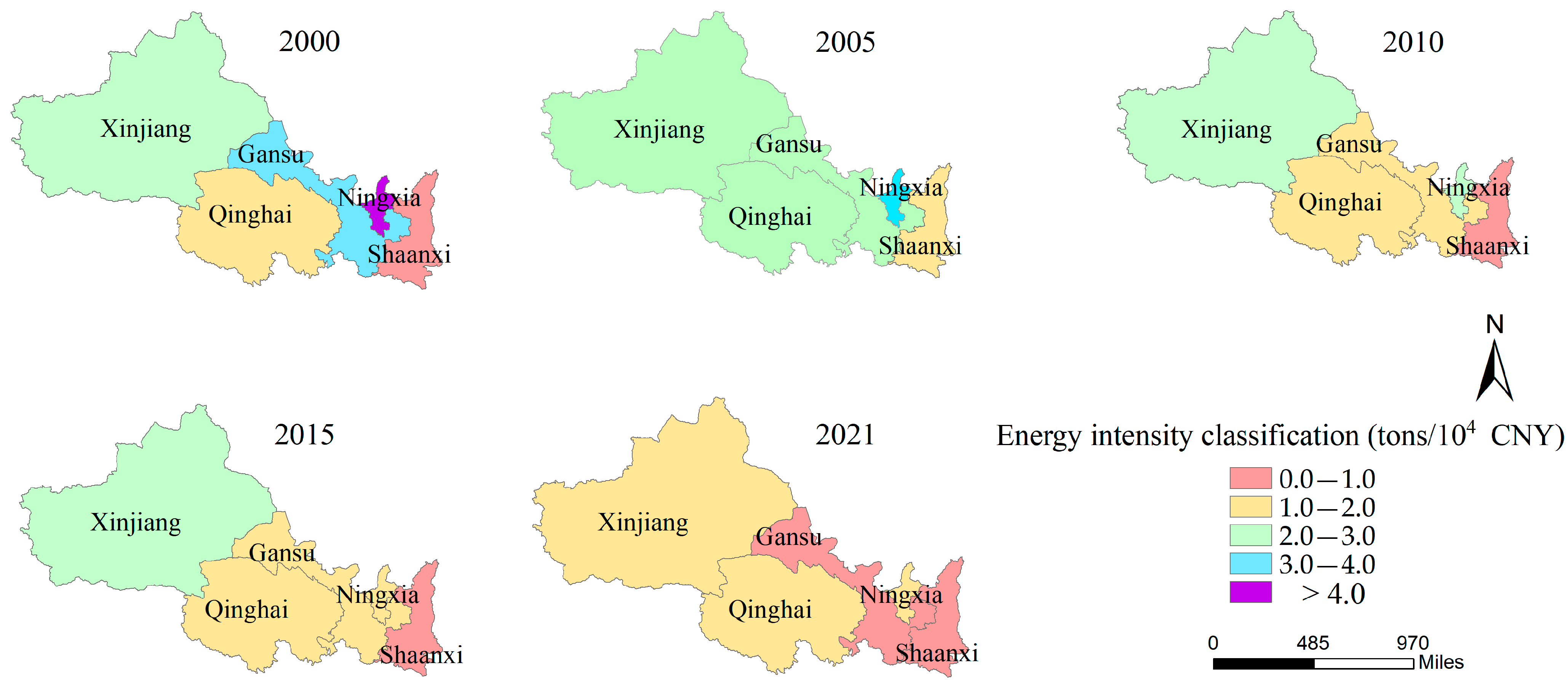
| Method | Industrial Structure | Industrial Energy Intensity | Energy Structure | ||
|---|---|---|---|---|---|
| LLC | −15.8680 *** | −6.7824 *** | −3.8113 *** | −10.7632 *** | −12.2001 *** |
| IPS | −11.6247 *** | −5.5452 *** | −3.7529 *** | −6.8995 *** | −8.6583 *** |
| ADF | 82.8721 *** | 42.1036 *** | 36.7102 *** | 48.7000 *** | 62.6132 *** |
| PP | 112.431 *** | 49.1605 *** | 64.5830 *** | 46.498 *** | 84.0650 *** |
| Term | Kao | Pedroni |
|---|---|---|
| ADF t-Statistic | −7.3957 *** | |
| Panel PP-Statistic | −4.2184 *** | |
| Panel ADF-Statistic | −4.0202 *** | |
| Group PP-Statistic | −6.1995 *** | |
| Group ADF-Statistic | −5.0904 *** |
| Variable | Definition |
|---|---|
| Total energy intensity in period t | |
| Total energy consumption in period t | |
| Total GDP in period t | |
| Value added of industry i in period t | |
| Energy consumption of industry i in period t | |
| The m type of energy consumption of industry i in period t | |
| Value added of industry i as a share of GDP in period t (i = 1, 2, 3) | |
| Energy intensity of industry i in period t (i = 1, 2, 3) | |
| The m type of energy consumption of industry i in period t as a part of total consumption (i = 1, 2, 3) | |
| Energy intensity of province i in period t | |
| Average energy intensity of n provinces in period t | |
| N | Number of regions |
| Logarithm of energy intensity of province i in period t | |
| Average of the logarithm of energy intensity for n provinces in period t | |
| Logarithm of the annual change rate in energy intensity | |
| β | Energy intensity regression coefficient |
| α | Constant term |
| ε | Error term |
| i,t | Variable i in period t |
| βi | Coefficient of each variable |
| Variable | Absolute β Convergence | Conditional β Convergence |
|---|---|---|
| β | −0.01286 (−0.6385) | −0.3962 *** (−5.2871) |
| Industrial structure | −0.2235 ** (−2.9345) | |
| Industrial energy intensity | −0.2148 *** (−3.3417) | |
| Consumption structure | −0.1039 *** (−3.2353) | |
| R2 | 0.3895 | 0.7883 |
| Adjusted R2 | 0.2206 | 0.6824 |
| F-statistic | 2.3062 *** | 7.4453 *** |
| Log-likelihood | 97.5368 ** | 120.8814 *** |
| Spatial fixed effect (LR test) | 78.0905 | 41.6132 *** |
| Time fixed effect (LR test) | 88.5830 ** | 87.1327 *** |
| Space–time fixed effect | No | Yes |
Disclaimer/Publisher’s Note: The statements, opinions and data contained in all publications are solely those of the individual author(s) and contributor(s) and not of MDPI and/or the editor(s). MDPI and/or the editor(s) disclaim responsibility for any injury to people or property resulting from any ideas, methods, instructions or products referred to in the content. |
© 2025 by the authors. Licensee MDPI, Basel, Switzerland. This article is an open access article distributed under the terms and conditions of the Creative Commons Attribution (CC BY) license (https://creativecommons.org/licenses/by/4.0/).
Share and Cite
Zhang, Z.; Jia, J.; Zhong, C.; Lu, C.; Ju, M. Decomposition of Intensity and Sustainable Use Countermeasures for the Energy Resources of the Northwestern Five Provinces of China Using the Logarithmic Mean Divisia Index (LMDI) Method and Three Convergence Models. Energies 2025, 18, 1330. https://doi.org/10.3390/en18061330
Zhang Z, Jia J, Zhong C, Lu C, Ju M. Decomposition of Intensity and Sustainable Use Countermeasures for the Energy Resources of the Northwestern Five Provinces of China Using the Logarithmic Mean Divisia Index (LMDI) Method and Three Convergence Models. Energies. 2025; 18(6):1330. https://doi.org/10.3390/en18061330
Chicago/Turabian StyleZhang, Zhenxu, Junsong Jia, Chenglin Zhong, Chengfang Lu, and Min Ju. 2025. "Decomposition of Intensity and Sustainable Use Countermeasures for the Energy Resources of the Northwestern Five Provinces of China Using the Logarithmic Mean Divisia Index (LMDI) Method and Three Convergence Models" Energies 18, no. 6: 1330. https://doi.org/10.3390/en18061330
APA StyleZhang, Z., Jia, J., Zhong, C., Lu, C., & Ju, M. (2025). Decomposition of Intensity and Sustainable Use Countermeasures for the Energy Resources of the Northwestern Five Provinces of China Using the Logarithmic Mean Divisia Index (LMDI) Method and Three Convergence Models. Energies, 18(6), 1330. https://doi.org/10.3390/en18061330







